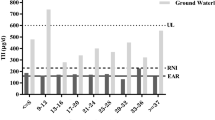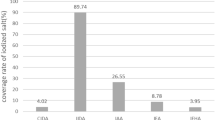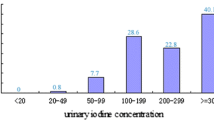Abstract
Purpose
Excess iodine in drinking water has emerged as a public health issue in China. This study assesses the effectiveness of removing iodized salt on reducing the iodine excess in populations living in high-iodine areas and also to identify the threshold value for safe levels of iodine in water.
Methods
Twelve villages from 5 cities of Hebei Province with iodine content in drinking water ranging from 39 to 313 µg/l were selected to compare the urinary iodine content of children aged 8–10 years before and after removing iodized salt from their diet.
Results
For 3 villages where median water iodine content (MWIC) was below 110 µg/l, following the removal of iodized salt (the intervention), the median urinary iodine content (MUIC) reduced to under 300 µg/l decreasing from 365, 380, 351 to 247, 240, 281 µg/l, respectively. However, the MUIC in the 9 villages with MWIC above 110 µg/l remained higher than 300 µg/l. The children’s MUIC correlated positively with the MWIC in the 12 villages (p ≤ 0.001). The linear regression equation after removing iodized salt was MUIC = 0.6761MWIC + 225.67, indicating that to keep the MUIC below 300 µg/l (the iodine excess threshold recommended by the WHO) requires the MWIC to be under 110 µg/l.
Conclusion
Removing iodized salt could only correct the iodine excess in the population living in the areas with MWIC below 110 µg/l. In the areas with water iodine above 110 µg/l, interventions should be focused on seeking water with lower iodine content. This study suggests a threshold value of 110 µg/l of iodine in drinking water to maintain a safe level of dietary iodine.

Similar content being viewed by others
References
Lv SM, Xie LJ, Zhou RH et al (2009) Control of iodine deficiency disorders following 10-year universal salt iodization in Hebei province of China. Biomed Environ Sci 22:472–479
Yu ZH, Zhu HM, Chen CY et al (1999) Proceedings on endemic goiter induced by high iodine. Chin J Endem 18:301–305 (in Chinese)
Ministry of Health (2003) National criteria for classifying high iodine regions. MOH, Beijing
Zhao JK, Chen ZP, Maberly G (1998) Iodine-rich drinking water of natural origin in China. Lancet 352:2024
Shen HM, Liu SJ, Sun DJ et al (2011) Geographical distribution of drinking-water with high iodine level and association between high iodine level in drinking-water and goitre: a Chinese national investigation. Br J Nutr 106:243–247
Burgi H (2010) Iodine excess. Best Pract Res Clin Endoc Met 25:107–115
Wang Y, Zheng HM, Wang CG et al (2005) Epidemiological investigation on water-sourced high level iodine goiter in Yellow river delta in Henan province. Chin J Endem 23:231–233 (in Chinese)
Zhang XD, Jia QZ, Wang ZH et al (2007) Epidemiological survey of inland water- borne high iodine in drinking water in Shanxi Province. Chin Tropl Med 17:679–681 (in Chinese)
Zhang ZZ, Fan J, Guo HY et al (2007) Distribution and goiter status of areas with high iodine in Inner Mongolia. J Baotou Med 23:566–568 (in Chinese)
Lv S, Xu D, Wang Y et al (2014) Goitre prevalence and epidemiological features in children living in areas with mildly excessive iodine in drinking-water. Br J Nutr 111:186–192
WHO/UNICEF/ICCIDD (2007) Assessment of iodine deficiency disorders and monitoring their elimination, 3rd ed. WHO, Geneva
Lv SM, Zhao J, Xu D et al (2012) An epidemiological survey of children’s iodine nutrition and goitre status in regions with mildly excessive iodine in drinking water in Hebei Province, China. Public Health Nutr 15:1168–1173
Pino S, Fang SL, Braverman LE (1998) Ammonium persulfate: a new and safe method for measuring urinary iodine by ammonium persulfate oxidation. Exp Clin Endocrinol Diabetes 106(Suppl 3):S22–S27
United Nations Children’s Fund (UNICEF) ROSCA (1998) The use of iodised salt in the prevention of iodine deficiency disorders—a handbook of monitoring and quality control. UNICEF ROSCA, New Delhi
Ministry of Health (2007) National surveillance plan for iodine deficiency disorders. MOH, Beijing (in Chinese)
Ministry of Health (2006) The standard test method for drinking water. MOH, Beijing (in Chinese)
Guo XW, Qin QL, Liu CJ et al (2007) Study on iodine nutritional status of target population due to different iodine concentrations in drinking water after stopping iodized salt. J Hyg Res 36:427–431 (in Chinese)
Li SM, Zhang GH, Gu YY et al (2009) Study on changing of iodine nutrition level of the people with unexcessive iodine drinking water in iodine excess area s after stopping supplies of iodized salt. Chin J Ctrl Endem Dis 24:107–109 (in Chinese)
Lv SM, Wang YC, Xu D et al (2013) Drinking water contributes to excessive iodine intake among children in Hebei, China. Eur J Clin Nutr 67:961–965
Guo XW, Qin QL, Chen ZP et al (2007) Iodine nutrition status of population in the areas with different iodine concentrations of drinking water. Acta Nutr Sin 29:526–530 (in Chinese)
Acknowledgments
This study was supported by Hebei Provincial Bureau of Science and Technology (Grant Numbers: 11276103D-3) and did not receive any other specific grant from commercial or not-for-profit sector, so the authors declare no conflict of interest. Shengmin Lv was responsible for the study design, data analysis, paper writing and investigation training. Yinglu Zhao, Yanxia Li, Yuchun Wang, Hua Liu and Yang Li were in charge of the field investigation and laboratory measurement in Xingtai, Handan, Hengshui, Cangzhou and Langfang city. Jun Zhao did the quality control of laboratory detection. Dr. Shannon Rutherford did the revision and English polishing. The authors thank the staff in endemic control department of CDC of the relevant counties involved in this study for their assistance in the field investigation.
Author information
Authors and Affiliations
Corresponding author
Rights and permissions
About this article
Cite this article
Lv, S., Zhao, Y., Li, Y. et al. Impact of removing iodized salt on the iodine nutrition of children living in areas with variable iodine content in drinking water. Eur J Nutr 54, 905–912 (2015). https://doi.org/10.1007/s00394-014-0767-z
Received:
Accepted:
Published:
Issue Date:
DOI: https://doi.org/10.1007/s00394-014-0767-z




